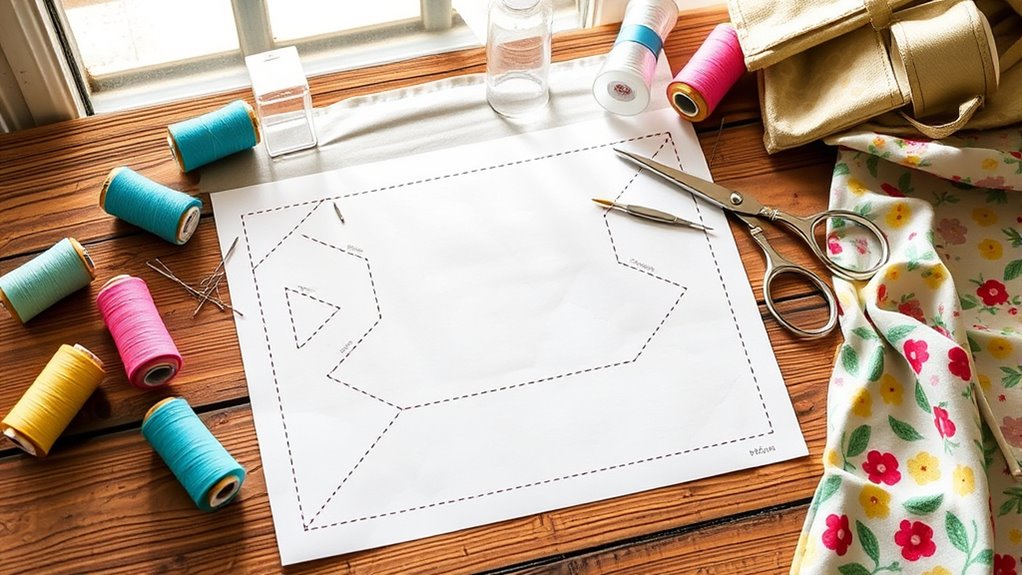To start your beginner tote bag, gather medium-weight fabrics like cotton or canvas, and essential tools like scissors, pins, and a sewing machine. Choose your fabric carefully; pre-wash it to avoid shrinking. Prepare your pattern, ensuring all pieces are included, and cut accurately. Sew the sides together, leaving a 1/4 inch seam allowance, and finish edges to prevent fraying. Personalize with embroidery or fabric paint. Continue to explore more tips and techniques to enhance your sewing skills!
Materials Needed
Before you plunge into sewing your tote bag, it’s vital to gather all the materials you’ll need. Start with fabric types; cotton is a versatile choice, while canvas offers durability.
You’ll want about half a yard for the outer layer and the same for the lining. Next, gather essential sewing notions: thread that matches your fabric, scissors for cutting, and pins to hold everything in place. Don’t forget a measuring tape for accuracy and a rotary cutter if you prefer clean edges.
A sewing machine is a must, along with a universal needle for most fabrics. If you’re adding pockets, consider interfacing for extra stability. Having your materials ready will make the sewing process smoother and more enjoyable.
Choosing Your Fabric
When you’re ready to choose your fabric, consider both the look and functionality of your tote bag. For a sturdy and durable option, cotton canvas is a fantastic choice. It’s available in various colors and patterns, making it easy to find something that fits your style.
If you’re looking for something more textured, upholstery fabric can also work well, providing extra durability while adding a unique flair. Just make sure it’s not too heavy for your design. Remember to think about the bag’s purpose—if you’ll carry heavy items, opt for thicker materials. Don’t forget to pre-wash your fabric to prevent shrinking and color bleeding. With these tips, you’ll select the perfect fabric for your tote bag!
Preparing Your Pattern
After selecting the perfect fabric for your tote bag, it’s time to prepare your pattern. Start by printing or tracing your pattern pieces, ensuring you’ve got all the necessary components. If your pattern has multiple pieces, lay them out on your fabric to visualize the fabric layout. This step is essential for efficient cutting.
Check for any markings like notches or grainlines; they’ll guide you in aligning the fabric correctly. When laying out your pieces, remember to take into account the direction of the fabric’s print, if any. Make sure you’ve got enough space around each piece to avoid cutting into seams. Finally, pin or weigh down your pattern pieces to keep everything in place during cutting. Happy sewing!
Cutting the Fabric
Now that you’ve prepared your pattern, it’s time to cut your fabric. Choose a fabric that’s durable yet easy to work with, like cotton canvas or denim, and make certain you take accurate measurements for each piece. Double-check your cuts to guarantee everything aligns perfectly, as precision will make a significant difference in your final tote bag.
Fabric Selection Tips
Choosing the right fabric is vital for your tote bag project, as it directly impacts both its appearance and durability. To help you make informed decisions, consider the following tips:
- Fabric Types: Opt for sturdy materials like canvas or denim for durability. If you’re going for a lighter bag, cotton or linen can work well.
- Color Combinations: Think about how colors will complement each other. Using contrasting colors can make your bag pop, while similar shades can give a more subtle look.
- Pattern Selection: Choose patterns that reflect your style, but make certain they’re not too overwhelming, which can distract from the bag’s functionality.
Accurate Measurements Importance
Once you’ve selected the perfect fabric for your tote bag, it’s time to focus on cutting your materials accurately. The importance of accuracy in measurements can’t be overstated; even a small mistake can throw off your entire project.
Use measurement techniques like a clear ruler or a quilting mat to guarantee precise cuts. Always double-check your dimensions before cutting, and consider marking your fabric with tailor’s chalk for visibility. When laying out your fabric, align the grain lines to avoid distortion.
Remember to cut slowly and steadily for clean edges, and don’t rush the process. Accurate measurements lead to a well-constructed tote bag that you’ll be proud to carry. Happy sewing!
Sewing the Bag Sides
To assemble the bag sides, start by aligning your fabric pieces with right sides together, ensuring they’re neatly stacked. Pin them in place, making sure to leave a seam allowance of about 1/4 inch. If you’ve made seam allowance adjustments, double-check that they’re consistent across all pieces.
As you sew, keep an eye on matching fabric patterns; this will make your tote bag look professional and polished. Here are a few tips:
- Use a walking foot if working with thicker fabric to avoid slipping.
- Reinforce corners with backstitching for added durability.
- Press seams open after sewing for a crisp finish.
Following these steps will help you create sturdy, attractive bag sides!
Adding the Handles
Before you attach the handles, it’s essential to determine their placement for ideal comfort and style. For a classic tote, place the handles about 3-4 inches from the top edge of your bag, ensuring they’re evenly spaced. If you’re using a thicker handle type, like webbing or leather, adjust the placement slightly higher for better support.
Mark the spots with fabric chalk or pins to avoid mistakes. When attaching, use a sturdy stitch, like a zigzag, to reinforce the handle placement. If you prefer a more modern look, consider cross-body handles, which may require different placement, closer to the bag’s center. Whichever handle type you choose, make sure they’re securely fastened for durability and comfort.
Constructing the Bag Bottom
As you prepare to construct the bag bottom, it’s important to affirm that your fabric pieces are cut to the appropriate dimensions for stability and shape. To ascertain your tote bag has the necessary strength, consider adding bottom reinforcement.
- Use interfacing for added durability.
- Sew in a sturdy fabric layer for extra support.
- Double stitch the corners for enhanced bag stability.
Start by aligning your fabric pieces and pinning them in place. Then, sew along the edges, making sure to reverse stitch at the beginning and end for secure seams. Remember, a well-constructed bottom will help your bag maintain its shape and carry heavier items without risk of tearing. Happy sewing!
Finishing the Edges
Now that you’ve constructed the bag bottom, it’s essential to finish the edges for a polished look and added durability. You can choose from several techniques, like using bias tape or employing a serger or zigzag stitch, each offering unique benefits. Let’s explore these options so you can select the best method for your tote bag.
Choosing Edge Finishing Techniques
When it comes to finishing the edges of your tote bag, selecting the right technique can make a significant difference in both durability and appearance. Here are some effective edge finishing options you can consider:
- Zigzag Stitch: This simple stitch prevents fraying while adding a decorative touch. Use a medium stitch length for best results.
- Overlock Stitch: If you have an overlock machine, this technique provides a professional finish that’s sturdy and neat.
- Bias Tape: Applying bias tape can create a clean edge while offering a pop of color or pattern.
Experiment with these methods to find what suits your style and skill level. Don’t hesitate to incorporate decorative stitches for an added flair to your tote bag!
Benefits of Bias Tape
Bias tape is an excellent choice for finishing the edges of your tote bag, offering both aesthetic appeal and functionality. It comes in various bias tape types, including single-fold and double-fold, allowing you to choose based on your project’s needs. For a clean look, opt for double-fold bias tape, which encases the raw edges neatly.
When applying bias tape, start by aligning it with the edge, pinning it down to secure. Sew along the fold, ensuring to catch the fabric underneath. This not only prevents fraying but also adds a decorative touch. Finally, pressing the bias tape after application can enhance its appearance, making your tote bag look professional and polished.
Serging vs. Zigzag Stitch
While both serging and using a zigzag stitch can effectively finish the edges of your tote bag, each method has its unique advantages. Here’s a quick breakdown to help you decide:
- Serging benefits: This technique trims and finishes in one step, providing a clean, professional look. It’s especially great for knit fabrics that fray easily.
- Zigzag applications: Ideal for those without a serger, a zigzag stitch can prevent fraying while allowing for some stretch, making it suitable for woven fabrics.
- Ease of use: If you’re a beginner, the zigzag stitch is straightforward to implement on most sewing machines, while sergers may require more practice.
Choose the method that suits your project and equipment best, ensuring your tote bag has polished edges!
Personalizing Your Tote
Personalizing your tote can turn a simple bag into a unique expression of your style. One great way to do this is through custom embroidery. You can use an embroidery machine or hand-stitch your initials, a favorite quote, or even fun designs. Just make certain to choose thread colors that complement your fabric.
Another option is fabric paint. Get creative by stenciling patterns or freehanding designs directly onto your tote. Before you start painting, test your technique on a scrap piece of fabric to ascertain the results match your vision. Don’t forget to let everything dry completely before using your tote. By adding these personal touches, you’ll have a tote that’s truly one-of-a-kind!
Tips for Future Projects
As you tackle future sewing projects, keep in mind the importance of selecting the right fabric for durability and style. Don’t forget to gather essential tools like sharp scissors and a reliable sewing machine to make your experience smoother. Finally, consider how you might modify patterns to create unique designs that reflect your personal taste.
Fabric Selection Tips
Choosing the right fabric is essential for any sewing project, especially when making a tote bag. Consider these tips to guarantee you select the best materials:
- Fabric Weight: Opt for medium-weight fabrics like canvas or denim for durability, while still being easy to sew.
- Color Coordination: Choose colors that complement your style. Neutral tones are versatile, but don’t shy away from bold prints to make a statement.
- Texture Variety: Mixing textures can add visual interest. Pair a smooth fabric with a textured one to elevate your bag.
Lastly, always check the fabric care instructions to guarantee your tote remains beautiful through washing and use. Happy sewing!
Essential Tools Needed
While sewing your tote bag, having the right tools can make all the difference in ensuring a smooth process. First, you’ll need a reliable sewing machine; it should be easy to use and have a straight stitch function. Next, a measuring tape is essential for accurate fabric cutting.
Measure twice to avoid mistakes! Don’t forget sharp fabric scissors for clean edges and a rotary cutter for quicker cuts. A cutting mat can protect your surfaces while providing a grid for precision. Pins or clips will help secure your fabric layers together, and a seam ripper is a must for correcting any errors. These tools will not only help with your tote bag but future projects as well!
Pattern Modification Ideas
Once you’ve mastered the basics of sewing your tote bag, exploring pattern modifications can elevate your skills and personalize your creations. Here are some ideas to get you started:
- Color Blocking: Experiment with different fabric colors and patterns to create a stylish color-blocked effect. This adds visual interest and can be a fun way to use up fabric scraps.
- Pocket Placement: Adjust the size and position of pockets based on your needs. Consider adding a zipper pocket for security or a larger front pocket for easy access.
- Strap Length: Customize the length of your straps. Make them longer for a crossbody style or shorter for a chic handbag look.
These modifications will help you create unique tote bags tailored to your style!
Frequently Asked Questions
What Are the Best Fabrics for Beginners?
You’ll love working with cotton canvas and denim twill; they’re like the superheroes of fabrics! Durable, easy to sew, and forgiving, they’ll make your projects a breeze. Plus, they come in so many fun colors!
Can I Use a Sewing Machine for This Project?
Yes, you can use a sewing machine for this project. For beginners, a basic mechanical or electronic machine works well. Make certain you’ve got the right needle and thread, and practice on scrap fabric first.
How Long Does It Typically Take to Sew a Tote Bag?
It typically takes about 2 to 4 hours to sew a tote bag, depending on your experience. To enhance project efficiency, organize your materials beforehand and practice any techniques you’re unsure about before starting.
What Are Common Mistakes to Avoid While Sewing?
You shouldn’t rush fabric choices or ignore proper sewing techniques. Always pre-wash fabrics to avoid shrinkage, use the right needle for your material, and double-check seam allowances to prevent frustrating mistakes during assembly.
Can I Modify the Pattern for a Different Size?
Yes, you can modify the pattern for different sizes. Just scale the pattern evenly, adjusting the tote dimensions while maintaining proportions. Use a ruler for accuracy, and check your adjustments before cutting fabric.


